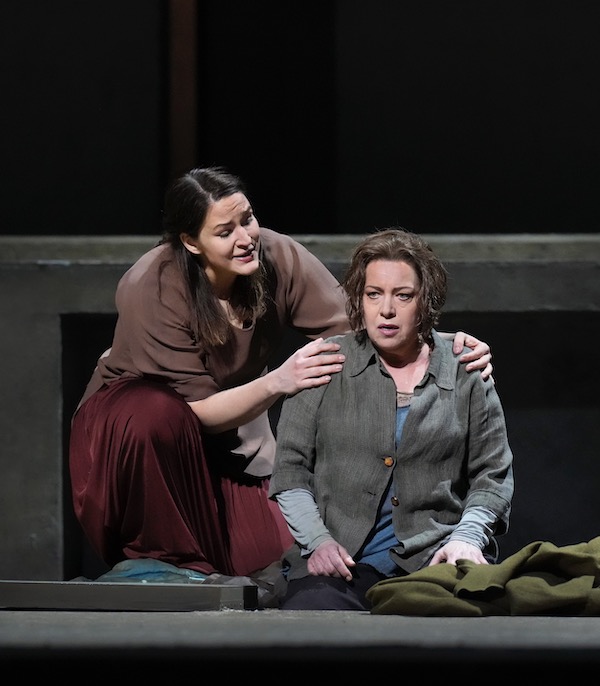Stemme and Davidsen bring vocal gleam, sibling complexity to Met’s “Elektra”

There was no April 1st tomfoolery about the Metropolitan Opera’s first Elektra of the season. With Nina Stemme in the title role, Lise Davidsen making her much-anticipated role debut as Chrysothemis, and Greer Grimsley as Orest, the company assembled a cast that would be hard to equal. Michaela Schuster as Klytämnestra was simply the icing on the cake.
Although dissimilar in many ways, Stemme and Davidsen had a natural ease together on stage that made their sisterhood plausible. There is scant lightness in the drama, and the sisters’ relationship is complex, but Stemme exhibited a bit of playfulness when she straddled Davidsen, trying to convince her that it was her duty to murder Klytämnestra and Aegisth. One could imagine them in happier times, before their mother married the man who murdered their father, at play rather than at loggerheads.
Perhaps it was that chemistry that made Stemme’s Elektra appear lighter and more nuanced, both psychologically and vocally, than when she first appeared in the role at the Met in 2016.
Stemme’s voice has darkened a bit in recent years, but that only adds to the intensity of her Elektra. There were piercing high notes, but also ones that emerged full and vibrant, resounding through the hall.
Stemme’s Elektra was surprisingly feminine at times, especially during the Recognition Scene, where she reminds Orest that she too was once beautiful with long, luxurious hair. For a moment, this Elektra was not so very different from her sister.
But Elektra’s obsession for revenge has stunted her mentally, as well as physically. Elektra’s attempts to dance as she imagines her triumph over the demise of Klytämnestra and Aegisth were awkward and halting. After the murder there is no ecstasy or triumph; Stemme’s Elektra sits mute and motionless, as if she has been turned to stone.
Grimsley’s Orest displayed the same familiar bond when he realizes that the seemingly deranged woman is his sister. As much paternal, as it was fraternal, the emotion was nonetheless real. Grimsley sang as he appeared — stoic, imposing and solid.
Davidsen was among vocal peers. At the first performance of Ariadne auf Naxos last month, the soprano at times overpowered the other singers on stage, but that was not the case Friday night. On the few occasions when Strauss permitted Chrysothemis to give full voice to her emotions, Davidsen filled the Met with thrilling sound as few singers can.
There was more, however, to Davidsen’s Chrysothemis than her voice, and Davidsen conjured up the young woman’s dreams as well. Youthful, impetuous and just a bit gawky, her Chrysothemis was at times skittish and at others determined. She is much like her mother with her willingness to let bygones be bygones, so that she can get on with life.
Schuster’s Klytämnestra was an elegant woman, not a bejeweled and debauched harridan, which is so often the case. If maternal love didn’t exude from her, there was nonetheless a softness in some of her interactions with Elektra. Vocally, she was also an exceptionally multifaceted villainess. The power was there, but also moments of softer, beautiful singing, when mother and daughter seemed to be engaged in actual conversation, rather than the constant of hurling thunderbolts at one another.
Stefan Vinke, who has sung Siegfried at the Met, was luxury casting as Aegisth. Handsomely turned out in jacket, vest and trousers, Vinke was only required to bluster about the stage a bit and get stabbed in the back.
As the Young Servant, tenor Thomas Capobianco made a vivid impression through a combination of physical energy and ringing voice. Mezzo-soprano Tichina Vaughan and soprano Hei-Kyung Hong, who has sung leading roles at the Met since her debut in 1984, were clear audience favorites among the maids who scurry about the palace.
Patrice Chéreau’s well-traveled Elektra, which was first seen at the Met in 2016 and revived in 2018, is straightforward, but impressive. Updated to an unspecified modern time, the setting is a barren inner courtyard with massive stone walls and a large arch that leads to the inner rooms of the palace. The only color comes from a red carpet that servants place on the landing when Klytämnestra deigns to visit Elektra. Subtle lighting depicts the passage of the hours of the day.
From the ominous four-note theme that opens the opera, Runnicles instilled drama into the performance. The tension that he summoned from the orchestra prior to Klytämnestra’s entrance, and later as Orest enters the palace to kill her, was overwhelming.
The Met Orchestra sounded glorious, but it wasn’t all loud and terrifying. Runnicles injected lightness and brilliance into Strauss’s score whenever possible. At times, the luminous, transparent string sound seemed to transport one to the eighteenth-century Vienna of Der Rosenkavalier.
Runnicles’ sense of pacing and balance were evident at all times. The latter, in particular, was key to presenting Davidsen to her best advantage. She wasn’t alone, however, in enjoying a ride on the scintillating carpet of sound that Runnicles so expertly summoned from the Met Orchestra.
Elektra continues through April 20. metopera.org